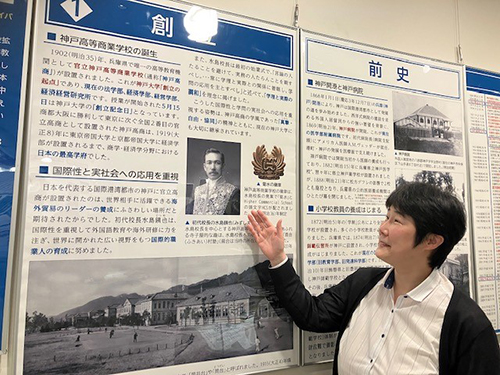May 15 marks the anniversary of Kobe University’s foundation, the day on which the former Kobe Higher Commercial School (Kobe Kosho) started classes in 1903. In those days, the imperial universities and old-style high schools typically used to start each academic year in September. However, it is said that Kobe Kosho’s first President, MIZUSHIMA Tetsuya, didn’t like the time wasted after the spring graduation of the junior high schools and therefore decided that Kobe Kosho would accept new entrants each spring. So, it could be said that even as it was just starting out Kobe University was already breaking with fashion and demonstrating a pioneering mindset.

Located close to Kobe port which provided a great base for Japan’s international trade, the former Kobe Kosho set itself the target of educating internationally minded people to flourish in the outside world. As Mizushima commented during the opening ceremony, “Our main target is to develop people who undertake their own large-scale commercial activities or overseas trading. By constantly focusing on the link between scientific principles and reality, we must strive to put learning into practice.”
NOMURA Rieko, Deputy Head of Kobe University Archives, says that in addition to adopting the spring entry, Mizushima implemented other innovative educational ideas such as extending the opportunities for high quality education by allowing graduates from commercial schools to enter the university—actions which at times put him on a collision course with government policy. Moreover, he strove to promote foreign language studies and overseas training programs as he kept a keen focus on international matters. And, exactly as Mizushima had intended, Kobe Kosho indeed went on to produce many alums who became active on the world stage, such as TAKAHATA Seiichi and NAGAI Kotaro who established Nissho Co. (now Sojitz Corp.) after their previous employer, Suzuki & Co., had gone bankrupt. IDEMITSU Sazo, the founder of Idemitsu Kosan was another prominent graduate.
It is apparent however that controversy over the timing of Foundation Day persisted for many years. This arose because the creation of the modern Kobe University in 1949 involved the integration of no fewer than seven separate schools. These included the Kobe University of Economics (Kobe Kosho in a later form), the College Preparatory Course of Kobe University of Economics, Himeji High School, Kobe Technical College, and Hyogo Normal School. This constituted the most complicated arrangement of any of the Japanese national universities[1]. Each of the seven schools had been established at different times so attempts to use the date of Kobe Kosho’s establishment as Foundation Day encountered strong opposition. This apparently led to each school holding its own separate celebration in the early days of the new university and it took until 1955 to finally adopt May 15 as Foundation Day.
While Foundation Day provides just a fleeting glimpse of Kobe University’s diversity and history, the full history of the University is introduced through the Kobe University History Exhibition on permanent display at the Kobe University Archives. To mark the 120th anniversary the content was renewed in 2022 with photographs, year descriptions and documentation presented in an easy to understand, compact format. As Nomura points out, “By knowing the history of the university, you can get to learn more about that period. So please come and visit us this Foundation Day.”
[1] TERASAKI Masao, “A History of Modern Japanese Universities”



